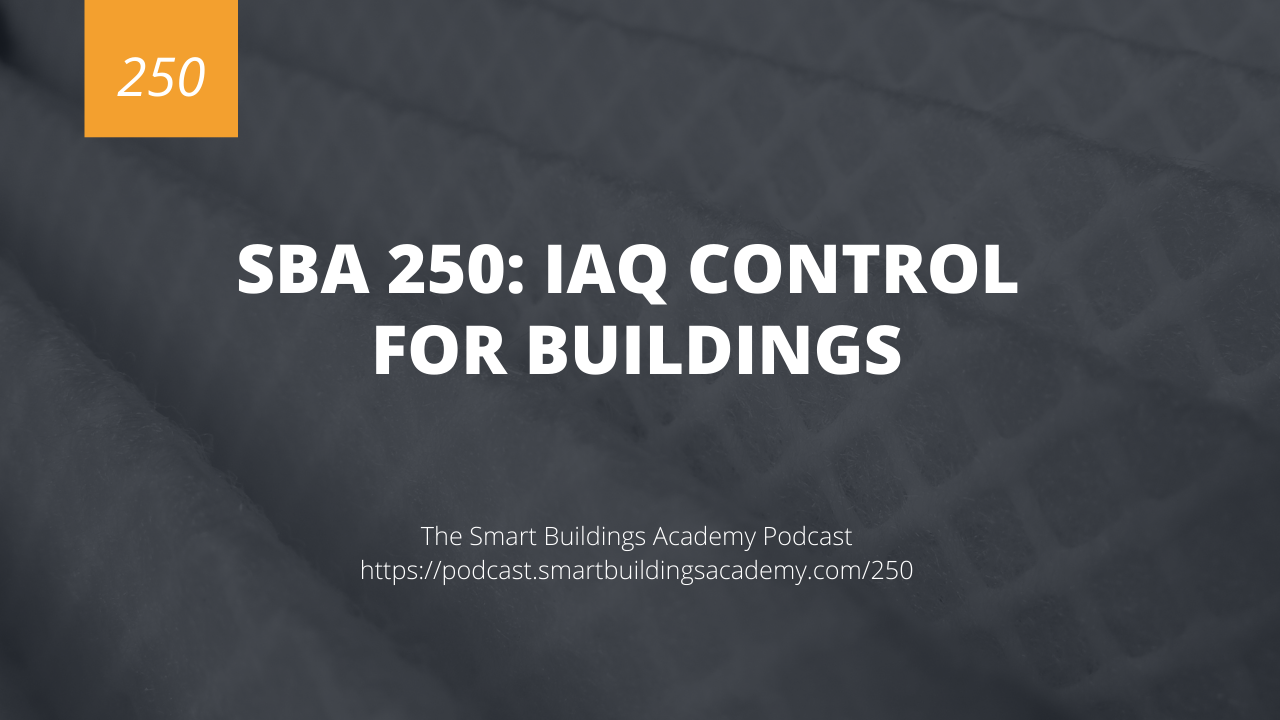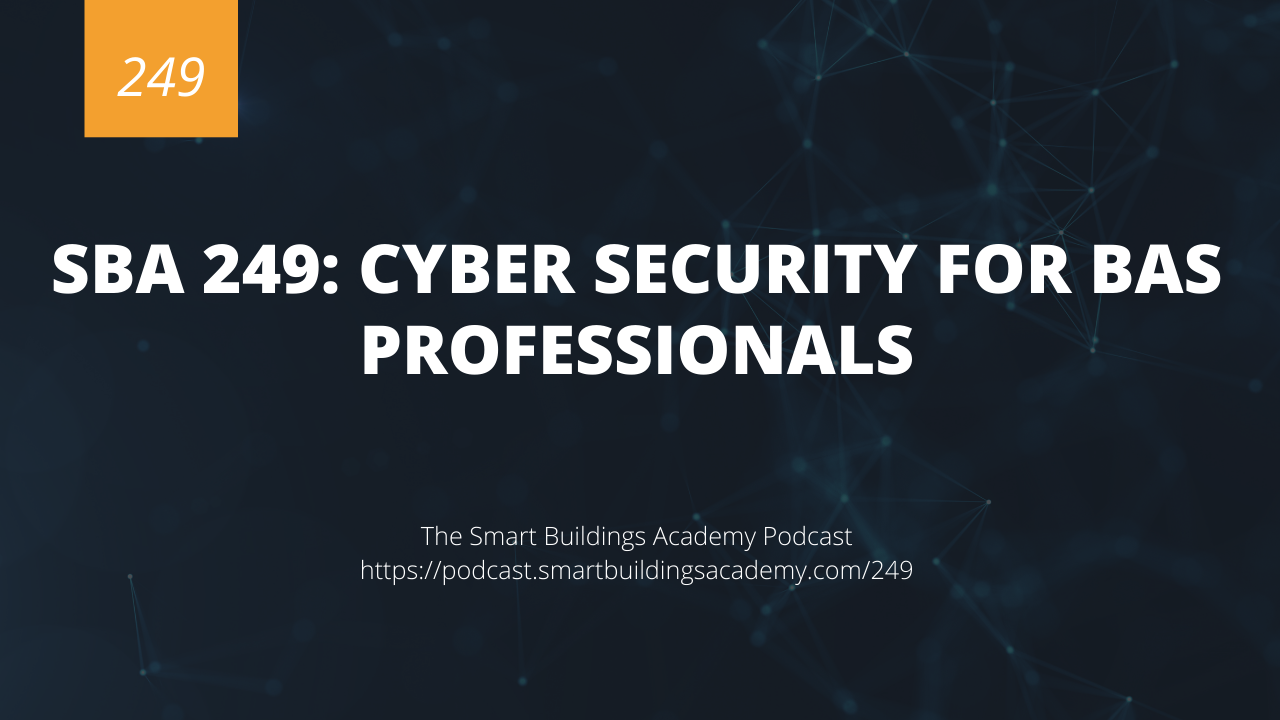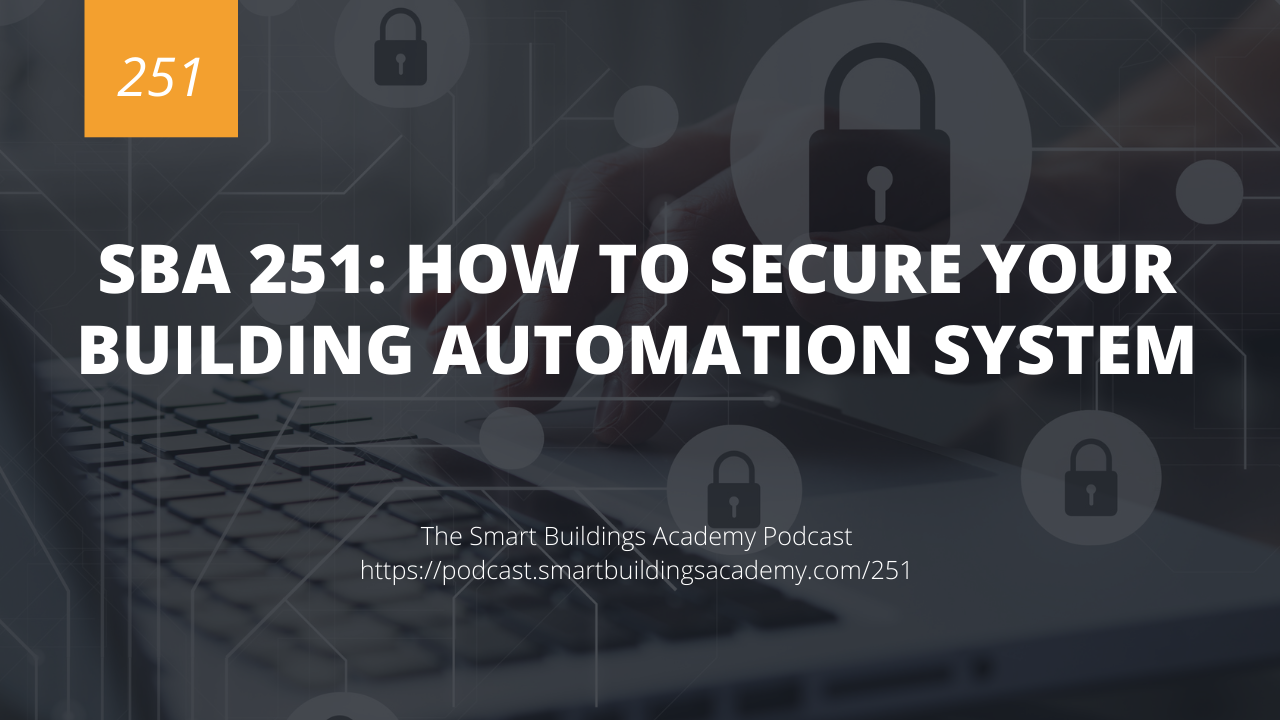In this episode of the Smart Buildings Academy Podcast, we discuss the new IAQ guidelines and sequences from ASHRAE.
We also look at how to implement IAQ within new and existing buildings and how you can communicate your IAQ efforts to your tenants.
Click here to download or listen to this episode now.
Resources mentioned in this episode
- IAQ Controls Webinar Sign Up/Replay
- ASHRAE Core Recommendations
- IAQ and Airflow 101
- Your IAQ Questions Answered
- Creating Your Own Pandemic Mode
- A Framework for Controls Changes Post-Covid


Transcript
Phil Zito 0:00
This is the smart buildings Academy podcast with Phil Zito Episode 250. Hey folks, Phil Zito here and welcome to Episode 250 of the smart buildings Academy podcast. I know it's been a couple weeks, we've had a lot of changes here at smart buildings Academy we've recently hired three corporate account executives to handle all of our customers. We've seen tremendous growth over the past couple weeks and months, so we needed to expand the size of our team. In this week's episode, we are going to be discussing IQ control for buildings and actually moving forward we are going to be having two episodes a week. So on Mondays you're going to get an episode focused on a topic from a knowledge perspective. And then on Wednesdays, you're going to be getting an episode that's going to be focused on a how to so this week we're gonna have IQ control for buildings and then Episode 251 on Wednesday is going to be focused on how to do cybersecurity. Everything we discuss here can be found at podcast dot smart buildings Academy comm Ford slash 250. Once again, that is podcast at smart buildings Academy comm Ford slash 250. And this week's podcast is sponsored by our upcoming IQ control for building automation webinar, which will happen this Wednesday. And you will want to sign up for that and you can find the signup link for that at podcasts smart buildings academy.com Ford slash one or 250 Matt, it's been a long day, and it's only gonna get even more interesting. Alright, so I aq control for buildings. What is IQ is stands for indoor air quality, it is the quality of the air inside the building, I've got a whole episode on IQ fundamentals that I'll link to in the show notes. So I'm not going to dive into that I'm going to assume you understand that. But let's start by digging into the IQ guidelines. Now. I ACU used to be something I don't know about you. But for me, it was something that you were like, okay, we're going to maintain the CEO carbon monoxide in the parking garage. And we're going to maintain the indoor air quality within the patient rooms and operating rooms in the hospital other than that we maybe care about co2 to and our minimum ventilation rates to be compliant with 62.1. Other than that, and not too big of a deal, you know, then COVID comes along and no matter what you think about it, it's still smack the world with saying, hey, pay attention to IQ. And, you know, science is still out there regarding exactly what effect IQ and ventilation has on viral mitigation are some studies that say a lot, some studies say not so much. It's about exposure from a time perspective. You know what, I'm not here to argue that I'm just here to tell you that if your customers are asking you to better control IQ, and work with the guidelines that are out there, here's how you do it. And that's what this episode is going to cover. Now the hour, the guidelines used to be pretty vague. Fortunately, they've gotten less vague, when the first thing we're going to talk about is the ASHRAE epidemic Task Force corps recommendations. We're going to talk through what those are and then we're going to dive into how do we practically apply these in new builds and existing builds. And then if we have time, we will also talk about things like gamification, quantitative and qualitative IQ changes. Alright, so the core recommendations for indoor air quality, according to the ASHRAE epidemic Task Force document that I'm looking at right here are one you should follow all public health guidance following requirements around PP and distancing. Okay, that's, yeah, whatever. We've heard that so much. It's not very useful for us from a knowledge perspective, right. From a building automation perspective, we need to know what do we need to do with our controllers? What do we need to do with our h vac? What do we need to do and account for when it comes to increased loads on our building equipment like our central utility plants and our main air distribution systems? So the first thing we come into is ventilation filtration and cleaning. They recommend Merv 13 with a combination of air cleaners and or circulation, control
Phil Zito 4:56
and they recommend using outside air increasing out outside air, and we'll talk about the science related to this in just a little bit why we use three room changes why we're increasing outdoor airflow. Why Merv 13. All of these things that there wasn't a lot of good documentation on, you actually had to go dig for it pretty deep ASHRAE has done a really good job of bringing that information to the forefront in their COVID-19 resources and whether or not you are doing this for COVID-19 mitigation, or you just want to make you the indoor air quality of your building better. I think you'll come out of this episode with a better understanding of, you know, why do we use the filtration we use? Why do we use the outdoor air flows we use, etc? And what are the impacts air distribution, we want to go and make sure that we are promoting mixing of space air, there's this thing that says mixing of space air. They say it so many times in the documentation, a well mixed building, etc. But they never really define what a well mixed building is. And after doing a ton of googling, I haven't been able to find what the heck a well mixed building is. So any of you all who know what the heck a well mixed building is and what that means. Let me know because that is a very vague term. From an H fac systems operation perspective. Pretty straightforward, right? maintain temperature and humidity design set points. We'll talk about why that matters. Maintain clean air supply for design occupancy. Pretty straightforward, that's ASHRAE 62.1, just right off the bat. When necessary flush spaces between occupied periods operate systems for time required to achieve three air changes. We'll talk about why that matters. Limit re entry of contaminated air from er vs energy recovery units or having exhaust plumes exhaust units right next to outdoor air intakes. I don't know how much of an issue this really is. I mean, is it that in Decca set wheels and things like that we're really capturing contaminated air and reintroducing it. I wasn't able to find really any studies that said this is actually happening. So I'm not sure like, if I'm you, I'm sitting there thinking What can I do for the biggest bang for my buck, I'm going to focus on my air changes, I'm going to focus on my outdoor air, I'm going to focus on using auxilary things like Merv filters, UVC, ionization, etc. I'm going to make sure my systems actually work through some commissioning. And I'm going to use the heck out of some qualitative things like signage, and messaging to make people just feel comfortable. Because there is a psychological aspect to all of this as well to get people to reoccupy. Now, as we dig in, what do we do? Right? Well, the first thing we have to do, and I hammered this in our site analysis podcast that we had earlier. And that is, we have to know what we actually have, we have to understand what is in our building, in order for us to control it, and that's on a existing build. But that's also in a new build, we have to understand our sequences, we have to understand our MEP plans, we have to understand our spec set, we have to be able to understand everything that is being used and recommended in our building, so that we can go implement appropriate guidelines. Now, why this temperature and humidity? Well, I've talked about this in our IQ webinar last year, but basically, viral viruses, they get deactivated, they basically become less able to infect at a certain humidity rate. It has something to do with their moisture content. And I'm not going to dive into the science of that. But just realize that as you control relative humidity, you actually can go and reduce the effectiveness or effectiveness of viral loads.
Phil Zito 9:09
But what do we do for this increased ventilation? Since outdoor air is all over the place, everyone's talking about it. Everyone's saying we need more outdoor air, what can we do up to this point ASHRAE and other organizations really didn't have a recommendation. Now they do. So if you have a unit that is going to be serving multiple spaces, and so you're using, you know cooling coil, it's like a VA v unit, right, maintaining a common pressure but varying the DHT, then you're going to implement this increased oae based on cooling coil. Now there's a lot to the sequence that I don't like and I'll talk about that. Well, let's talk about how it actually works. You basically are going to look at the cooling coil control valve. And if it's less than 90% and the DA t are satisfied, you're going to open In the OD, the outdoor air damper closed the RA D. So just basically inverse proportional control. And you're going to open that outdoor air damper and close that return air damper 3% every 15 minutes. So there's some things I don't like here, you know, how long is the time period that you need to be in this 90% and discharge air temp satisfied state What does satisfied mean? Is that like a one degree dead band, what is that. And then what is your cap on this are you just gonna keep going because if you do this at nighttime, you could run into a scenario where there's no load, and you open up your damper all the way and then morning comes along, and you're trying to recover at but yet the unit is only slowly closing down. As we'll see, the coolant control valve is greater than 90%, or the DA T is exceeded by one degrees, then we're going to close the OD and open the RFID 6% every five minutes. But that may not be fast enough. So we may need something where we reset this actually during morning warm up to go and say hey, we're in morning warm up or morning cooldown mode, we're going to go and reset this outdoor damper at whatever percent It is to be.
Phil Zito 11:17
But we also have to go and flat, we also have to go and factor in the building flush, which we'll talk about that in just a second, then we have increased oae. Based on space conditions. This assumes that the coil leaving air temperature controls the chilled water valve to maintain a constant setpoint. Right. And so we're not going to be going and changing this. Supposedly, if the space temps are satisfied and relative humidity is less than 55. We open the OD every 3% every 15 minutes. Space temps are exceeded by one degree or the relative humidity is greater than 60. We can close the O ad open the ID 6% every five minutes is basically the same sequence. Except in this case, we're driving off of space tamps and relative humidity instead of driving off of the DA t. Now, here's the thing. I personally prefer the da te, rather than going off of space tamp in almost any trim in response scenario, which this is trim in response. Because what's going to happen with trim in response is you're going to have calls for cooling or you're going to have averaged values that are going to go and drive the sequence. And I don't like having multiple values that could oppose one another. In the case of space temps. They also mentioned slightly Hey, by the way, control pressurization as well. So Oh, thanks for telling us that. So that's something that they also want us to go and pay attention to, which is our pressurization, they want us to make sure that we go and control pressurization building flush. So for each mode, right, there's this building flush. And the thing I like about this that they explain is they actually give you the science between behind one air change three air changes, and five air changes for our building flush, which for those of you don't know what that means, that means we run our outside air at a certain percent until we've achieved three air change volumes. So three total volumes of fresh air in that space. And by doing that, if you look at the math, one air change achieves basically, point six 3%. So are sorry, 63% reduction, and you're looking at with three air changes, 95% reduction, and five air changes 99% reduction of contaminants in the space for a well mixed system, there comes that well mixed again. Now, the cool thing about that is you now have some science associated with all of that. Additionally, they go through Merv, and they talk about viral size, and they talk about e one, e two, e three. And that associates with small, medium and large, and most of our viral loads are in the E one to E two size. And Merv has a Merv 13 typically has like a 60 ish percent effectiveness on that. So it gives you kind of the science behind that which is nice, and they include this one spreadsheet as well. That enables you to see all of your things working together. If you've got UV, if you've got Merv, if you've got better outdoor air, how can you hit that optimal required air changes?
Phil Zito 14:49
Now the big thing that I like to focus in on is how do you implement this and new and existing buildings and new buildings. You're just going to go and take the exam. Testing spec language, and ensure that you have the appropriate IO sensors and capacity and control devices and implement that new spec language. In existing buildings, you're going to have to actually go in and probably retrofit, at least some of the control devices, maybe extend the capabilities of the controllers, so that they can inter network with one another to execute these sequences. Now, I want to talk about the difference between quantitative and qualitative IQ changes. So when we're talking quantitative, that's everything we've talked to up this point, right? You take metrics, you define what's good and bad. And then you go and you execute against those metrics, qualitative, though, or how you feel about something. And this is how you engage tenants, right? You need to go and use digital signage, print communication, all sorts of efforts to communicate a concise message to your occupants telling them, what is the risk, how are you addressing the risk? And how do you measure your success in addressing that risk. So this could be something like, here's the recommended air changes, here's what we achieve, and making it a green, yellow, red and having that dashboard it out from a digital signage perspective, so that people see that when they enter the building, and they feel more comfortable. There's much more to quantitative and qualitative IQ changes, but we're running up against the 15 minute time limit, actually, we're over it. And I want to keep these new episodes right around 15 minutes. So I'm going to call it with that on so Thanks a ton for being here. Go to podcast that smart buildings academy.com Ford slash 250. Once again, that's podcast that smart buildings academy.com Ford slash 250 to get access to all the links and show notes that are available, and that were mentioned in this podcast episode. Thanks a ton. I look forward to talking to you on Wednesday about cybersecurity. Thanks, ton. Take care.





